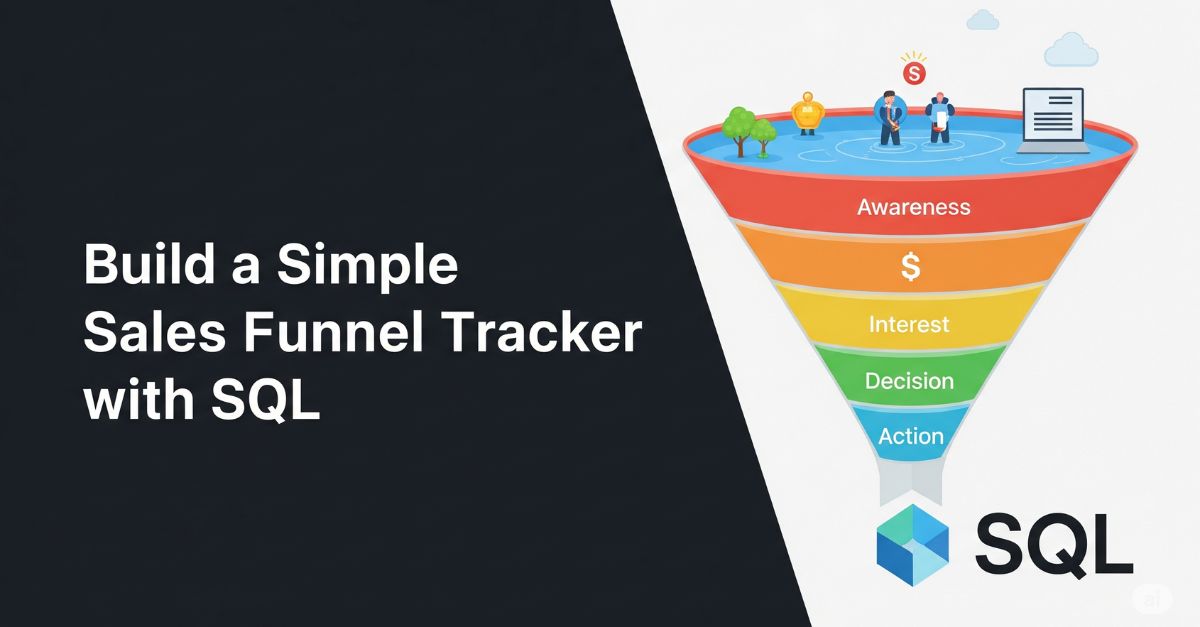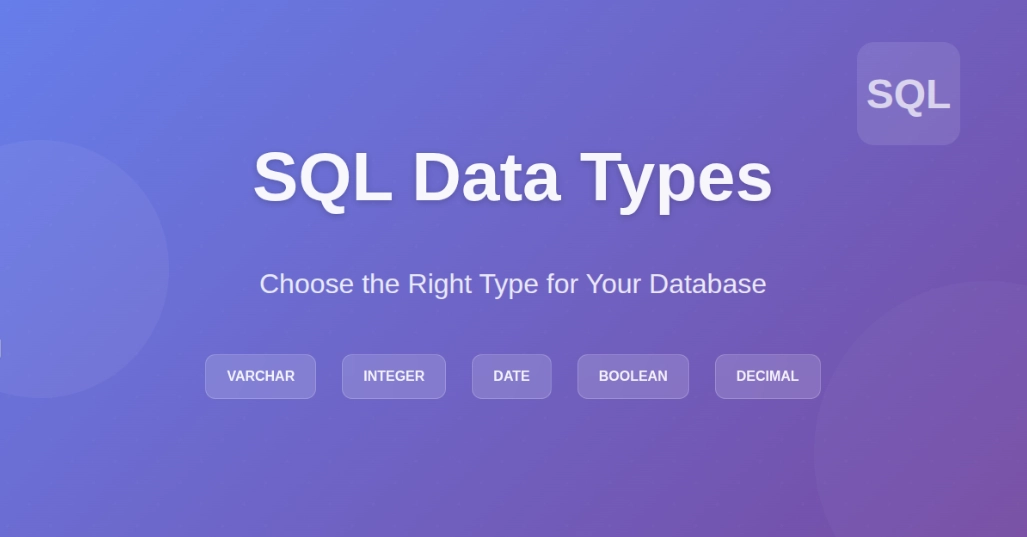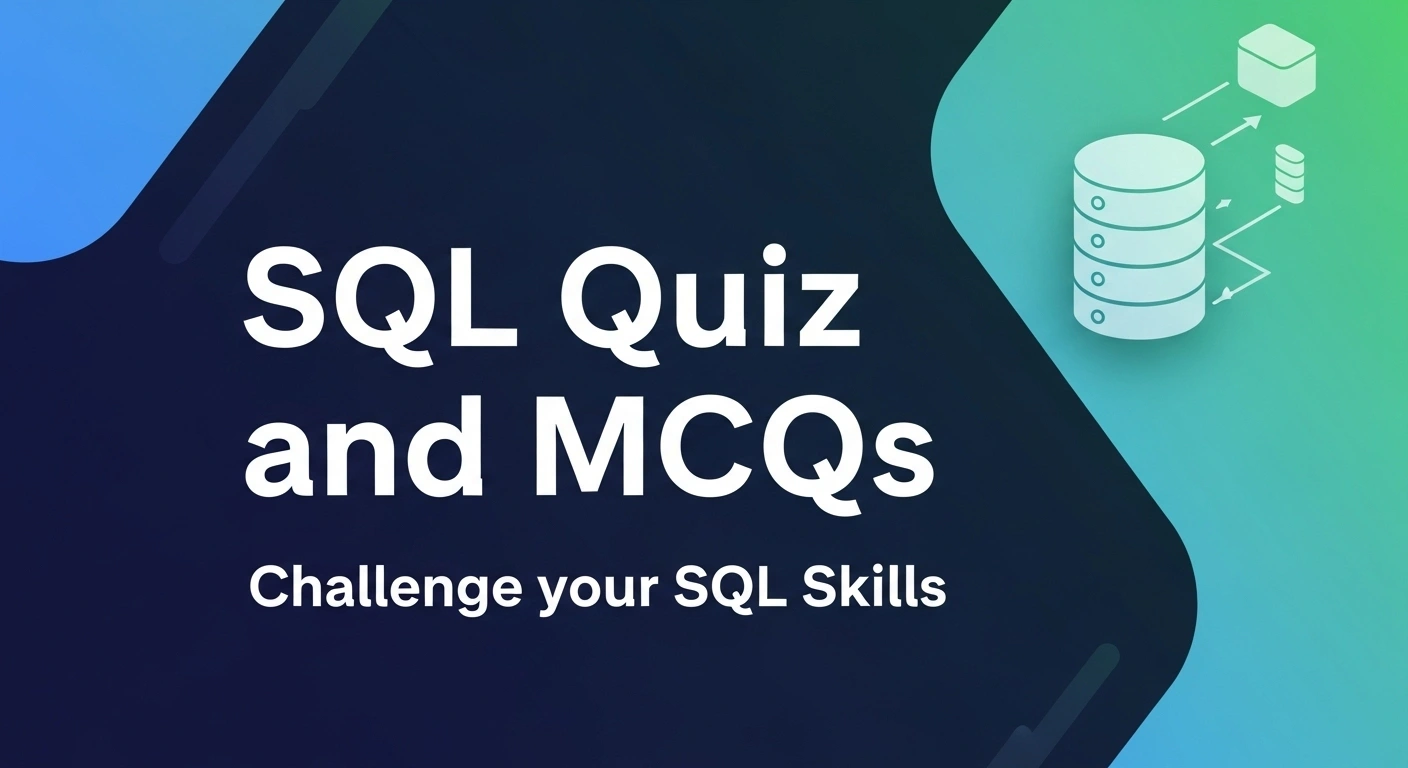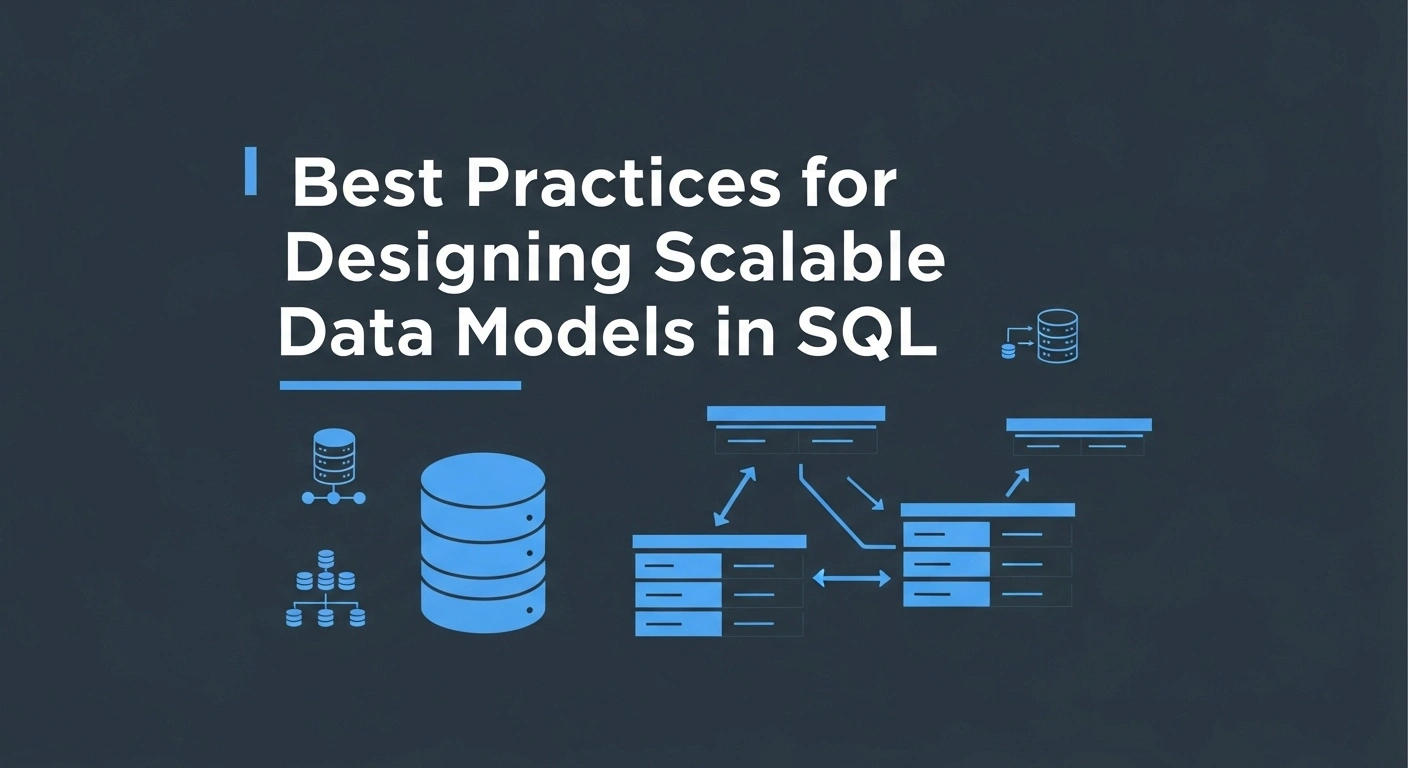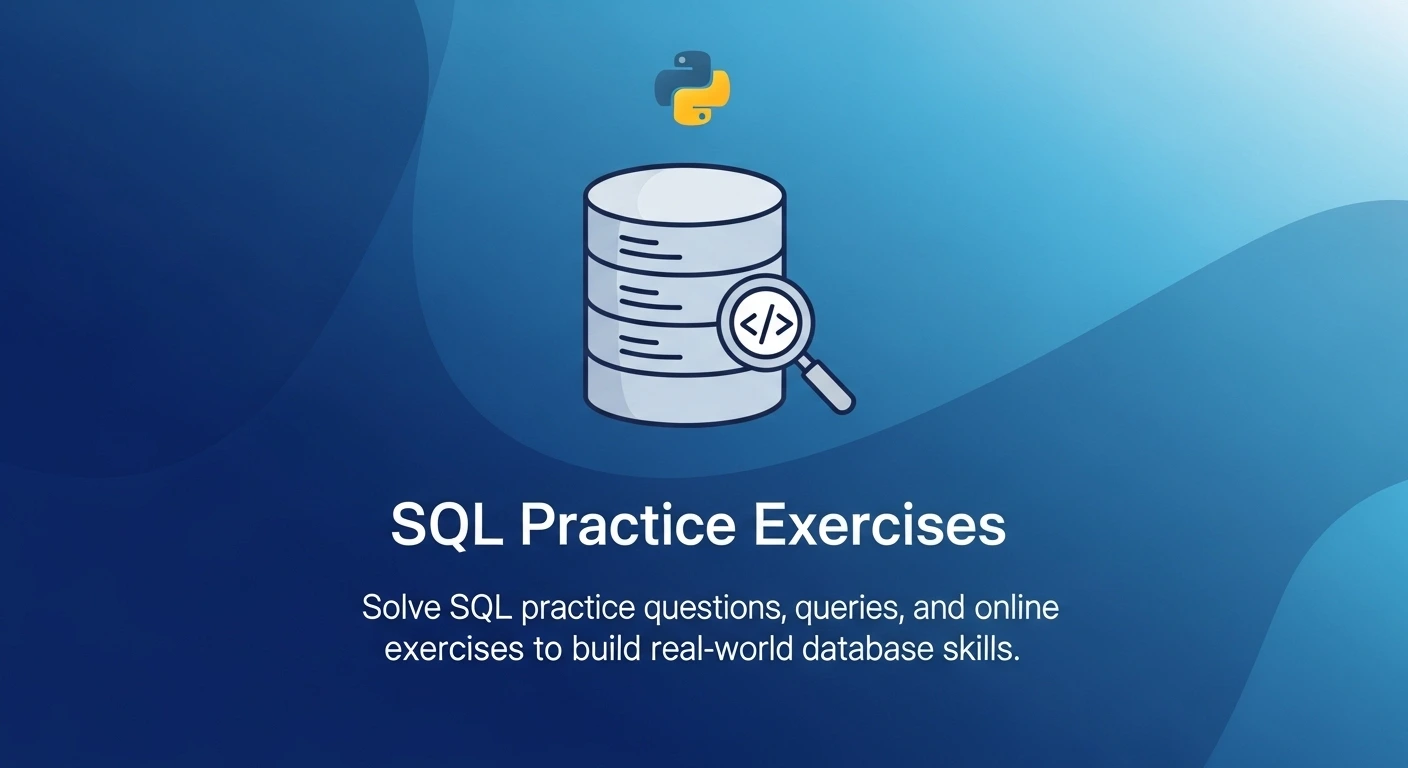- What is a Sales Funnel Tracker?
- Why Use SQL for Sales Funnel Tracking?
- How to Build a Simple Sales Funnel Tracker with SQL: Step-by-Step
- Real-World Applications and Scope
- Benefits of Learning Sales Funnel Tracking with SQL
- Latest Trends in SQL and Data Analysis
- Conclusion: Take the Next Step in Your Data Analytics Journey
- Frequently Asked Questions (FAQ’s)
Businesses are interested in learning about their customers and selling to them. A sales funnel tracker displays the process of movement of individuals interested in a product or service to the actual purchase. SQL is a nice option to develop a simple yet powerful tracker.
SQL assists you in accessing and analyzing the information about customers in a database quickly, thus identifying bottlenecks and increasing the conversion rates. Learning to create a sales funnel tracker through SQL is a substantial addition to any marketing professional, in-house sales analyst, or aspiring data analyst.
In this article, we will explore how to create a simple sales funnel tracker using SQL, discuss its scope in business analytics, provide practical examples, and highlight why mastering these skills through a Data Analytics in SQL & Excel Course can boost your career.
What is a Sales Funnel Tracker?
Sales funnel is an image that demonstrates the process a customer undergoes prior to purchasing. Typical stages might include:
- Awareness: The customer becomes aware of your product.
- Interest: The customer will be interested, say by going to your website.
- Consideration: The customer is more likely to subscribe to a demo.
- Decision: The customer makes the purchase.
A sales funnel tracker keeps the number of customers at each stage, the time spent at that stage, and the drop-off point. With such information, companies will be able to enhance their sales and marketing.
Why Use SQL for Sales Funnel Tracking?
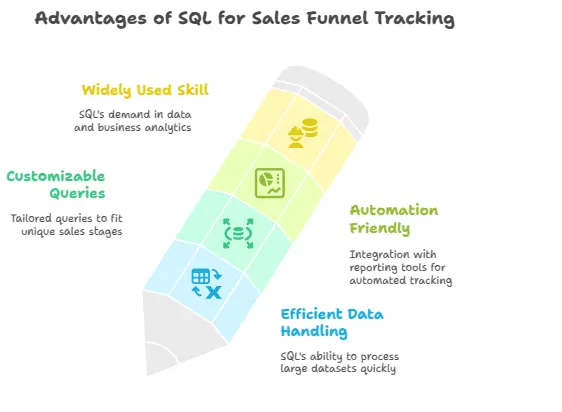
A large number of organizations store customer and sales data in a relational database. Which is why they tend to use SQL. Here’s why SQL is a perfect fit:
- Efficient Data Handling: SQL can process large volumes of data quickly.
- Customizable Queries: You can write queries tailored to your unique sales stages.
- Automation Friendly: SQL queries can be embedded in reporting tools for automated tracking.
- Widely Used Skill: SQL remains one of the most in-demand skills in data and business analytics.
Master SQL and Database management with this SQL course: Practical training with guided projects, AI support, and expert instructors.
How to Build a Simple Sales Funnel Tracker with SQL: Step-by-Step
Step 1: Define Your Sales Stages in the Database
Assuming you have a table named customer_events with columns like customer_id, event_type, and event_date, your first step is to map out the events that correspond to each stage in the funnel.
SELECT
customer_id,
MIN(CASE WHEN event_type = 'awareness' THEN event_date END) AS awareness_date,
MIN(CASE WHEN event_type = 'interest' THEN event_date END) AS interest_date,
MIN(CASE WHEN event_type = 'consideration' THEN event_date END) AS consideration_date,
MIN(CASE WHEN event_type = 'purchase' THEN event_date END) AS purchase_date
FROM
customer_events
GROUP BY
customer_id;
This query tracks the first time a customer reaches each stage.
Step 2: Calculate Funnel Drop-offs and Conversion Rates
Once you have the dates per stage, calculate how many customers moved through each stage and how many dropped off.
SELECT
customer_id,
awareness_date,
interest_date,
consideration_date,
purchase_date
FROM
(Your previous query here)
)
SELECT
COUNT(DISTINCT customer_id) AS total_customers,
COUNT(DISTINCT CASE WHEN awareness_date IS NOT NULL THEN customer_id END) AS aware,
COUNT(DISTINCT CASE WHEN interest_date IS NOT NULL THEN customer_id END) AS interested,
COUNT(DISTINCT CASE WHEN consideration_date IS NOT NULL THEN customer_id END) AS considered,
COUNT(DISTINCT CASE WHEN purchase_date IS NOT NULL THEN customer_id END) AS purchased
FROM
funnel;
This provides a snapshot of customer movement through your funnel.
Step 3: Analyze Time Between Stages
Understanding the time customers spend in each stage helps optimize sales cycles.
SELECT
AVG(DATEDIFF(day, awareness_date, interest_date)) AS avg_awareness_to_interest,
AVG(DATEDIFF(day, interest_date, consideration_date)) AS avg_interest_to_consideration,
AVG(DATEDIFF(day, consideration_date, purchase_date)) AS avg_consideration_to_purchase
FROM
funnel
WHERE
awareness_date IS NOT NULL
AND interest_date IS NOT NULL
AND consideration_date IS NOT NULL
AND purchase_date IS NOT NULL;
This query calculates the average time customers take to move through the stages.
Real-World Applications and Scope
Building a sales funnel tracker with Structured Query Language (SQL) is valuable in many industries:
- E-commerce: Track how users move from site visits to purchases and optimize marketing channels.
- SaaS companies: Monitor free trial signups converting into paid subscriptions.
- Retail: Analyze customer journeys across different marketing campaigns.
- Finance and Insurance: Understand client engagement stages and improve onboarding.
A report by Gartner for the year 2024 reveals an average conversion rate that is 20 percent higher when sales and marketing departments adopt data-driven sales funnel analytics. Such an observation highlights the importance of SQL proficiency in these roles.
Benefits of Learning Sales Funnel Tracking with SQL
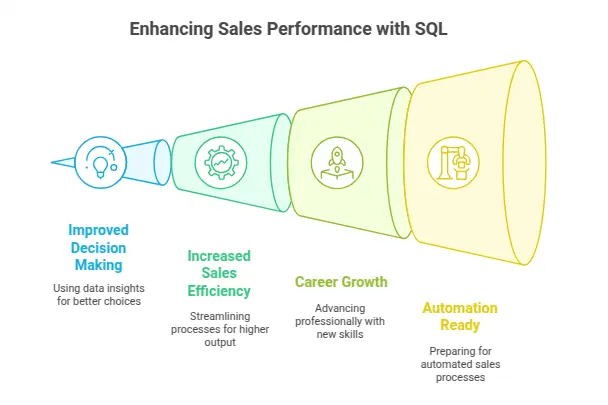
- Improved Decision Making: Real-time insights into customer behavior.
- Increased Sales Efficiency: Identify where leads drop off and focus on high-impact areas.
- Career Growth: SQL is essential for many business analyst and data analyst roles.
- Automation Ready: Easily integrate funnel tracking into dashboards and automated reports.
In case you want to know how to work with SQL and analyze sales data, then taking a data analytics SQL course can accelerate the process of learning and allow you to apply new concepts to practice quickly.
Latest Trends in SQL and Data Analysis
- SQL remains one of the top skills for data professionals according to LinkedIn’s 2024 Emerging Jobs Report.
- Companies increasingly combine SQL with visualization tools like Power BI or Tableau for dynamic sales funnel dashboards.
- Online learning platforms report a surge in enrollment for SQL and data analysis online courses, reflecting growing industry demand.
Conclusion: Take the Next Step in Your Data Analytics Journey
A straightforward sales funnel tracker SQL is a perfect choice to understand your sales process better and achieve better business results. Funnel tracking is a practical, high-impact skill, whether it is your first time dealing with data or you want to learn data analysis with Excel.
Frequently Asked Questions (FAQ’s)
What is a sales funnel tracker?
A sales funnel tracker is an application that allows companies to view the processes every prospective client goes through before deciding to make a purchase. It traces the customer through the cycle of awareness, interest, consideration and eventually purchase and this assists the companies in refining their sales process.
Why should I use SQL to track my sales funnel?
SQL is a suitable option to monitor sales funnels due to the ability of people to manage the data effectively, write custom queries, and create automated reports. It can help businesses to process huge amounts of data about customers, determine the conversion rate, and identify areas where the sales process becomes slow.
How do I set up the stages of a sales funnel in SQL?
The first thing you will have to do to establish the phases of the sales funnel in SQL is to establish the events associated with each phase in your database. This could be achieved by searching the customer data using event type such as awareness, interest, consideration and purchase. SQL is then able to monitor the first instance of every event by every customer.
Can I calculate drop-offs and conversion rates in my sales funnel using SQL?
Yes, SQL can keep track of the number of customers progressing through the stages of a sales funnel and those that fall off.516 You can calculate conversion rates and identify where leads go missing by writing queries, which trace the route through one stage to another.
How can I analyze the time customers spend in each stage using SQL?
SQL is able to count the average time each customer remains at each stage by comparing the date entry points. You can use DATEDIFF() to measure gaps between stages, e.g., awareness to interest, interest to consideration, and consideration to purchase.
What are some real-world applications of SQL for sales funnel tracking?
SQL tracking of the sales funnel is helpful in a variety of industries. In e-business, it enables individuals to understand how visits to the site are converted into sales. In the case of SaaS, it demonstrates how free trial subscriptions become paid ones. In retail, it exposes the various processes that customers undertake through the marketing campaigns. It improves conversion rates and client interaction in the finance and insurance sectors.
How can learning SQL for sales funnel tracking benefit my career?
By acquiring the skills in SQL to monitor the sales funnel, you develop better data analysis skills. You are able to make informed decisions using real-time information on customer behaviour. It also increases your ability to identify sales bottlenecks and thus enhances your worth in the field of data analysis and business analysis, which are in high demand in most industries.
